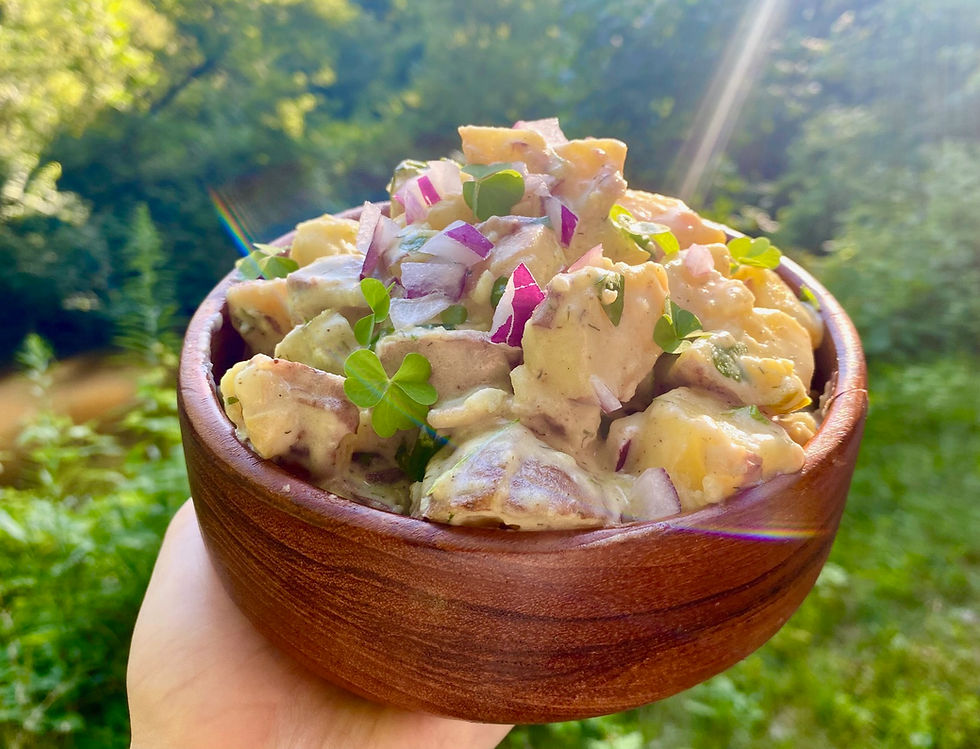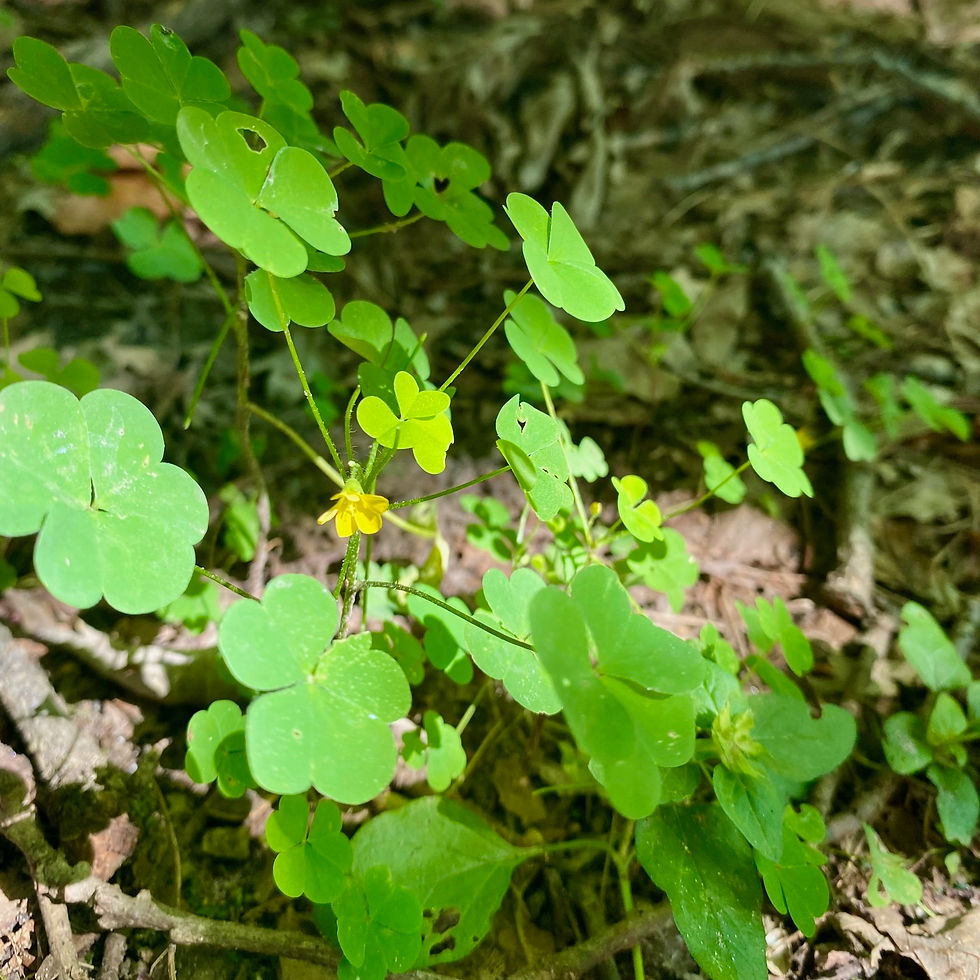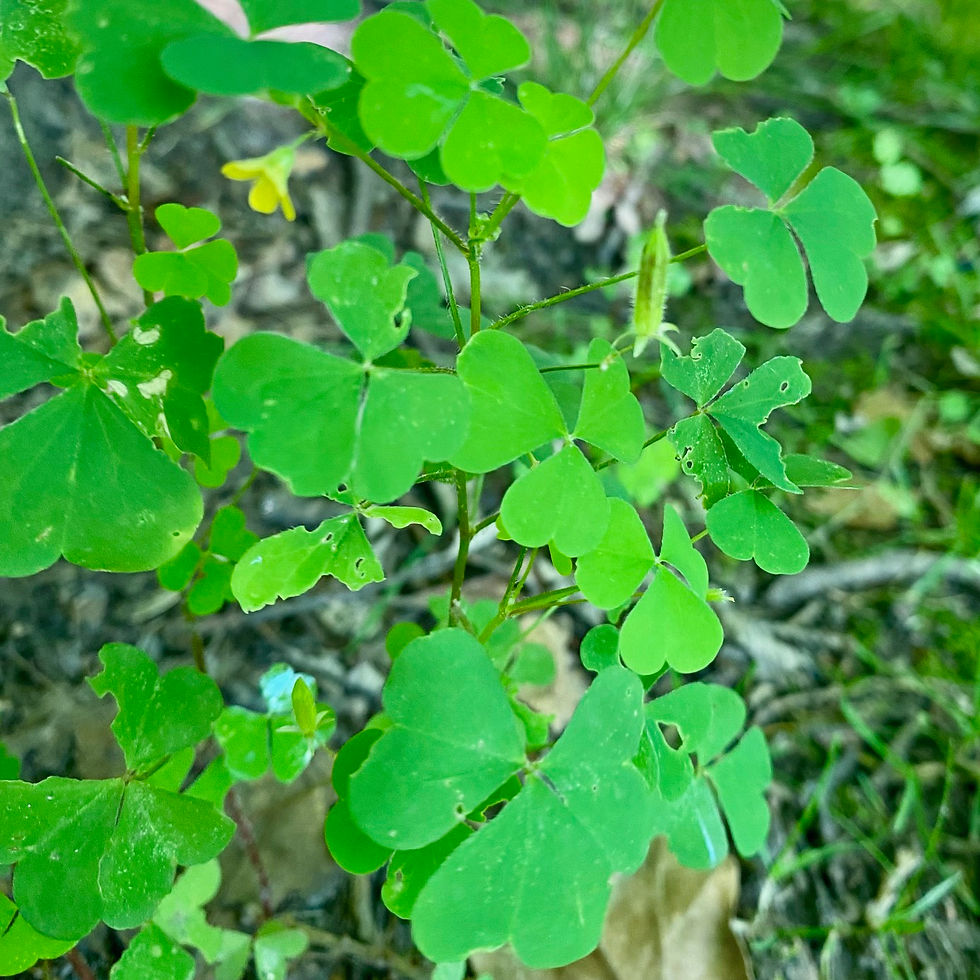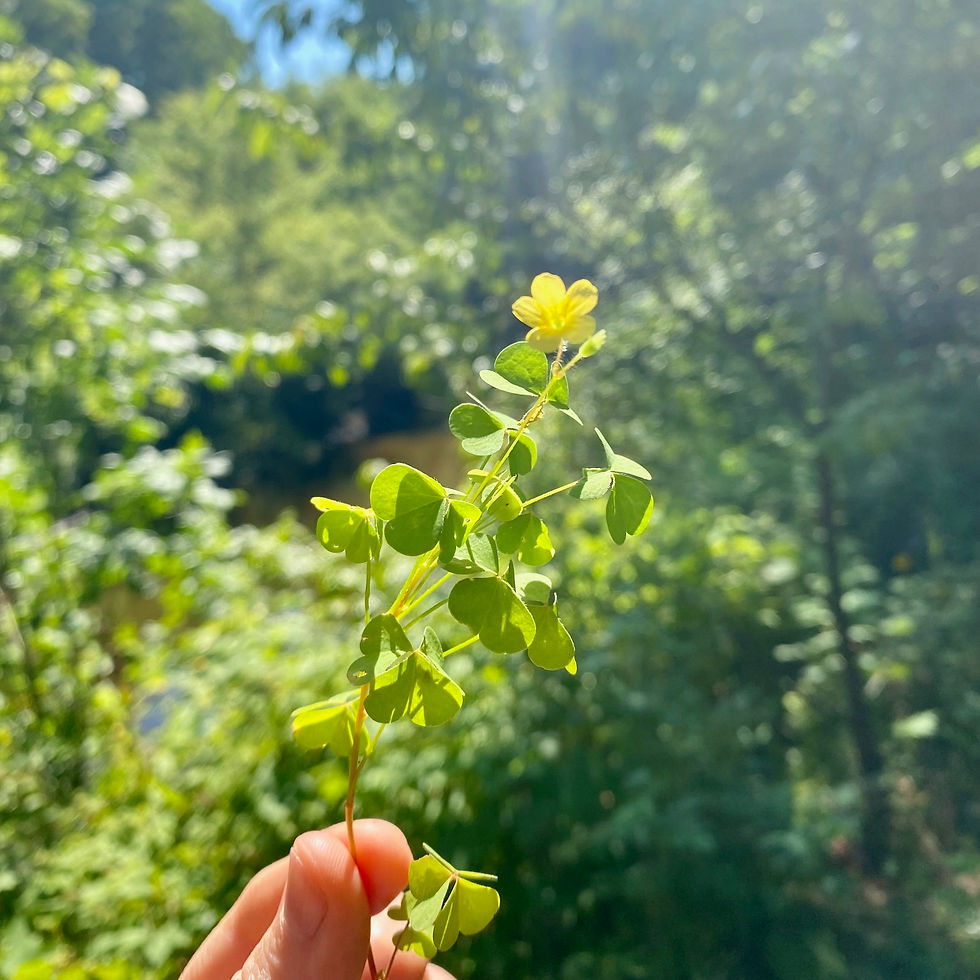Wood Sorrel Potato Salad (vegan, gluten-free)
Hearty with a surprising zing of freshness offered by our green friend Wood Sorrel, this potato salad is a wonderful and easy to make side to any meal!

WOOD SORREL
Sometimes mistaken for clover by the untrained eye, Wood Sorrel (Oxalis spp.) is a group of plants well worth getting to know! The Oxalis genus comprises numerous species (over 570!), yet they share specific characteristics. They can be recognized by their distinctive trifoliate (having three leaflets) leaves that resemble clover, as well as their dainty and often bright little flowers.
Unless you live in the polar regions, you will likely find one or more Wood Sorrel species growing near you, since they occur almost everywhere in the world. One of the species you'll commonly encounter on Turtle Island (North America) is Yellow Wood Sorrel (Oxalis stricta), which you will see in most of the the photos on this page. In Europe, a species that you'll often find is Common Wood Sorrel (Oxalis acetosella). In South America another Oxalis species, called Uqa or Oca (Oxalis tuberosa), grows in the Andes region and an grows a delicious edible root.

Wood Sorrels all over the world play important roles in their local ecosystems. Their flowers are not only a great food source for pollinators, but some species are also important host plants for different butterflies. Their underground tubers are eaten by various small mammals and even some birds. We humans generously receive different benefits from Wood Sorrels as well.
Wood Sorrels are some of the most interesting flavored wild plants you can find, with their leaves having a bright, lemony taste. This has made them a rather popular foraged food! The genus name for wood sorrel is Oxalis. The fresh flavor of their leaves is caused by the presence of oxalic acid. The words Oxalis and oxalic come from the Greek oxus, which translates as "sour." That makes sense then!
Next to their pleasant flavor, Wood Sorrel offers us various health benefits. They are high in vitamin C, and also contain vitamin A. People all around the world have been using species of Wood Sorrel to treat various ailments, including issues with digestion and the liver, fevers, nausea, eye complaints, sores, scurvy, and more. Some studies suggest that some Wood Sorrel species posses medicinal properties that include anti-oxidant, anti-inflammatory, and anti-microbial effects. They also assist with the proper management of fluids in our body. According to the Native American Ethnobotany Database, various tribes used different Wood Sorrel species for healing purposes. The Diné (Navajo) people used Creeping Wood Sorrel (Oxalis corniculata) as a an analgesic for pain and as a skin treatment, while the Cherokee even used the plant as a herbal medicine to treat cancer!
It is important to note that it is good to eat Wood Sorrel in moderation. When eaten in large quantities, oxalic acid can cause some problems with nutrient absorption in our digestive system. It is quite unlikely you would eat enough to experience any difficulty though. Besides, oxalic acid is also found in many common foods like coffee, chocolate, beets, and some leafy green vegetables.

FINDING WOOD SORREL
As we have seen, different species of Wood Sorrel can be found in almost all corners of the world. The plants will grow in various habitats, which include woodlands, hillsides, lawns, along roads, between the pavement, and other areas disturbed by human activity.
Wood Sorrel likes to grow in partial shade and moist soil, but they can also adapt to other light and soil conditions. Some species are also being cultivated by us, like Uqa or Oca (Oxalis tuberosa), grown as a root vegetable in the Andes and New Zealand, and Purple Shamrock (Oxalis triangularis), who lives indoors as a houseplant.
Wood Sorrels often grow in patches. Certain species, like Creeping Wood Sorrel (Oxalis corniculata), form low, dense mats. Others have a more upright growth pattern.

Most Wood Sorrel species are not incredibly hard to recognize once you know what to look for. One distinguishing characteristic many (but not all) share are their trifoliate leaves which have notched 'heart-shaped' leaflets. Interestingly, these leaflets show 'sleep movements', spreading open in light conditions, and folding together with stormy weather or when it gets dark. Depending on the species, the leaves can have various shades of green, purple, or reddish-brown (e.g. compare the coloring of the two different species shown in the photos above and below this paragraph). Wood Sorrel stems are rather thin and delicate. They are often green, but are reddish in some species. Their texture is usually smooth or with tiny hairs.

Wood Sorrel flowers come in a variety of colors, including white, and various shades of yellow, pink, red, and purple. The flowers all have five petals, five sepals, and ten stamens. They can bloom for multiple months, even year-round in warm climates.Their seed pods are long, small, and usually grow upright. When they are ripe, they 'explode' and shoot dozens to hundreds their seeds into the air.
Wood Sorrel could be confused with several other plants, which include: White Clover (Trifolium repens, white flower heads with many florets, leaves teardrop shaped), Alsike Clover (Trifolium hybridum, white-pink flower heads with many florets, and partially hairy stems), Red Clover (Trifolium pratense, pink flower heads with many florets, up to 80 cm/30 inches tall), and Black Medic (Medicago lupulina, leaves are oval and grow alternating along the stem, yellow flower head with many florets). Luckily, all of these look-a-likes are non-toxic, and even edible and medicinal. This means you don't have to worry too much about making a mistake when it comes to these specific species. Nonetheless, it is still important to consult a quality source of information when identifying Wood Sorrel or any other plants found in nature.
HARVESTING & PROCESSING WOOD SORREL
When it comes to Wood Sorrels, the whole plant is edible, and humans have been eating them for a long time. The leaves, stems, and flowers can be added to a great variety of dishes, including salads, soups, curries, baked goods, teas, and other drinks. They can be harvested from the spring to the fall, or year-round in warm climates. The tubers from the previously mentioned Uqa or Oca (Oxalis tuberosa) can be eaten raw (crunchy), or cooked like potatoes (softer/starchy texture). These are only harvested in the late fall/early winter.
For the recipe below, we will use only the aboveground parts of the plant. These are best harvested by carefully snipping some off with scissors, leaving the roots undisturbed. The leaves are delicate and don't keep well, so it's best to use them right away, or if necessary place them in a container in the fridge to use as soon as possible. Since Wood Sorrel also grows in areas disturbed by humans, it is important to avoid using plant material from areas that could be contaminated or treated with chemicals like pesticides.
Please remember that whether you're working with Wood Sorrel or any other living being in nature, it’s important to walk softly on the Earth and to forage with care. We are guests and receivers of gifts from the nature around us, so please consider how you can do this respectfully and only take as much as you need. When you harvest Wood Sorrel, maybe you could consider to, in your own way, offer a small gesture of gratitude to the plants that so generously give you part of themselves.

VISUAL GUIDE FOR WOOD SORREL RECIPE
After learning a lot about Wood Sorrel, the time has now come to make your delicious salad! You can follow along with the steps you see in the images below, as well as use the written out Wood Sorrel potato salad recipe below.

WOOD SORREL POTATO SALAD RECIPE
Disclaimer: Every year there are people that are poisoned or experience other negative health effects from eating inedible wild plants or mushrooms that resemble edible species. For this reason it's essential to ensure proper species identification and to consult multiple quality sources for doing this. It's also important to consider your unique health considerations before consuming wild foods. Always check and follow all local foraging regulations before you harvest anything in nature.


















Comentários